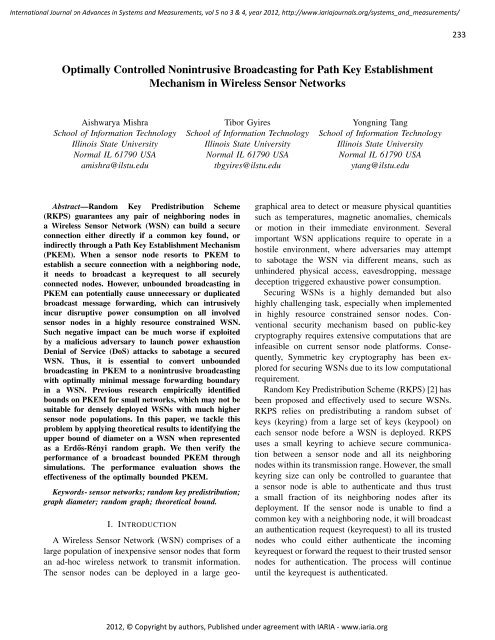c - IARIA Journals
c - IARIA Journals
c - IARIA Journals
You also want an ePaper? Increase the reach of your titles
YUMPU automatically turns print PDFs into web optimized ePapers that Google loves.
International Journal on Advances in Systems and Measurements, vol 5 no 3 & 4, year 2012, http://www.iariajournals.org/systems_and_measurements/<br />
Optimally Controlled Nonintrusive Broadcasting for Path Key Establishment<br />
Mechanism in Wireless Sensor Networks<br />
Aishwarya Mishra<br />
School of Information Technology<br />
Illinois State University<br />
Normal IL 61790 USA<br />
amishra@ilstu.edu<br />
Abstract—Random Key Predistribution Scheme<br />
(RKPS) guarantees any pair of neighboring nodes in<br />
a Wireless Sensor Network (WSN) can build a secure<br />
connection either directly if a common key found, or<br />
indirectly through a Path Key Establishment Mechanism<br />
(PKEM). When a sensor node resorts to PKEM to<br />
establish a secure connection with a neighboring node,<br />
it needs to broadcast a keyrequest to all securely<br />
connected nodes. However, unbounded broadcasting in<br />
PKEM can potentially cause unnecessary or duplicated<br />
broadcast message forwarding, which can intrusively<br />
incur disruptive power consumption on all involved<br />
sensor nodes in a highly resource constrained WSN.<br />
Such negative impact can be much worse if exploited<br />
by a malicious adversary to launch power exhaustion<br />
Denial of Service (DoS) attacks to sabotage a secured<br />
WSN. Thus, it is essential to convert unbounded<br />
broadcasting in PKEM to a nonintrusive broadcasting<br />
with optimally minimal message forwarding boundary<br />
in a WSN. Previous research empirically identified<br />
bounds on PKEM for small networks, which may not be<br />
suitable for densely deployed WSNs with much higher<br />
sensor node populations. In this paper, we tackle this<br />
problem by applying theoretical results to identifying the<br />
upper bound of diameter on a WSN when represented<br />
as a Erdős-Rényi random graph. We then verify the<br />
performance of a broadcast bounded PKEM through<br />
simulations. The performance evaluation shows the<br />
effectiveness of the optimally bounded PKEM.<br />
Keywords- sensor networks; random key predistribution;<br />
graph diameter; random graph; theoretical bound.<br />
I. INTRODUCTION<br />
A Wireless Sensor Network (WSN) comprises of a<br />
large population of inexpensive sensor nodes that form<br />
an ad-hoc wireless network to transmit information.<br />
The sensor nodes can be deployed in a large geo-<br />
Tibor Gyires<br />
School of Information Technology<br />
Illinois State University<br />
Normal IL 61790 USA<br />
tbgyires@ilstu.edu<br />
Yongning Tang<br />
School of Information Technology<br />
Illinois State University<br />
Normal IL 61790 USA<br />
ytang@ilstu.edu<br />
graphical area to detect or measure physical quantities<br />
such as temperatures, magnetic anomalies, chemicals<br />
or motion in their immediate environment. Several<br />
important WSN applications require to operate in a<br />
hostile environment, where adversaries may attempt<br />
to sabotage the WSN via different means, such as<br />
unhindered physical access, eavesdropping, message<br />
deception triggered exhaustive power consumption.<br />
Securing WSNs is a highly demanded but also<br />
highly challenging task, especially when implemented<br />
in highly resource constrained sensor nodes. Conventional<br />
security mechanism based on public-key<br />
cryptography requires extensive computations that are<br />
infeasible on current sensor node platforms. Consequently,<br />
Symmetric key cryptography has been explored<br />
for securing WSNs due to its low computational<br />
requirement.<br />
Random Key Predistribution Scheme (RKPS) [2] has<br />
been proposed and effectively used to secure WSNs.<br />
RKPS relies on predistributing a random subset of<br />
keys (keyring) from a large set of keys (keypool) on<br />
each sensor node before a WSN is deployed. RKPS<br />
uses a small keyring to achieve secure communication<br />
between a sensor node and all its neighboring<br />
nodes within its transmission range. However, the small<br />
keyring size can only be controlled to guarantee that<br />
a sensor node is able to authenticate and thus trust<br />
a small fraction of its neighboring nodes after its<br />
deployment. If the sensor node is unable to find a<br />
common key with a neighboring node, it will broadcast<br />
an authentication request (keyrequest) to all its trusted<br />
nodes who could either authenticate the incoming<br />
keyrequest or forward the request to their trusted sensor<br />
nodes for authentication. The process will continue<br />
until the keyrequest is authenticated.<br />
2012, © Copyright by authors, Published under agreement with <strong>IARIA</strong> - www.iaria.org<br />
233







